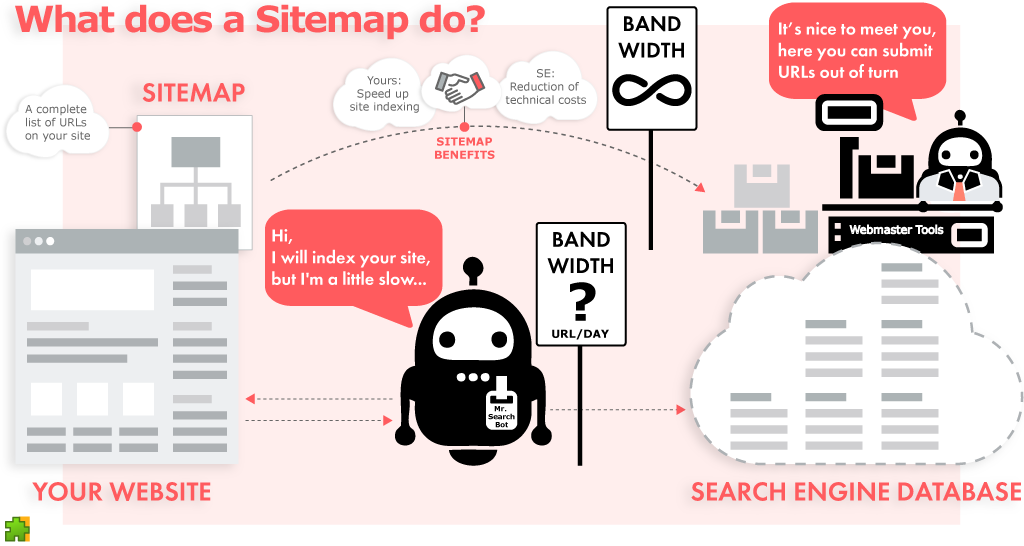Uncover the mystery behind sitemaps and how they play a crucial role in boosting your website’s SEO ranking.

Image courtesy of via DALL-E 3
Table of Contents
Introduction to Sitemaps
Have you ever heard of a “sitemap”? It may sound like something you use for exploring a new city, but in the digital world, a sitemap is like a map for a website. Just like a map helps you find your way around a city by showing all the roads and landmarks, a sitemap shows all the pages on a website. This makes it easier for visitors and search engines to navigate and find what they are looking for.
What is a Sitemap?
A sitemap is a tool used by website owners to organize and showcase all the different pages on their website. It’s like a blueprint that lays out the structure of a website, making it easier for visitors to explore and discover all the content available. Just imagine trying to find your favorite book in a library without a proper catalog—it would be a real challenge! That’s where a sitemap comes to the rescue, helping users quickly locate the information they need.
Why Do Websites Need Sitemaps?
Websites need sitemaps for a variety of reasons. Firstly, sitemaps enhance the user experience by providing a clear navigation path for visitors. Instead of getting lost in a sea of web pages, users can easily locate the information they seek with the help of a sitemap. Secondly, search engines like Google use sitemaps to crawl and index websites more efficiently. This means that having a sitemap can improve your website’s visibility in search engine results, making it easier for people to find your site online. So, sitemaps are not just beneficial for humans but also for the digital robots that help organize the internet!
Types of Sitemaps
When it comes to sitemaps, there are different types that serve various purposes. Let’s explore the two main types of sitemaps: HTML sitemaps and XML sitemaps.
HTML Sitemaps
An HTML sitemap is like a table of contents for your website, displaying all the pages in a structured format that is easily accessible to visitors. It typically includes links to all the important sections of your site, making it simple for users to navigate and find what they are looking for.
For example, imagine you are in a library looking for a specific book. The library catalog acts as an HTML sitemap, guiding you to the right section and shelf where the book is located. Similarly, an HTML sitemap on a website helps users find the content they need quickly and efficiently.
XML Sitemaps
On the other hand, XML sitemaps are designed more for search engines than human visitors. These sitemaps provide additional information about the website’s pages, such as when they were last updated or how important they are in relation to other pages on the site.
Think of XML sitemaps as a special language that search engines like Google use to understand the structure and content of a website better. By using XML sitemaps, website owners can help search engines crawl and index their pages more effectively, ultimately improving the site’s visibility in search results.
How to Create a Sitemap
Creating a sitemap for your website doesn’t have to be a complicated process. There are online tools available that can help you generate a sitemap quickly and easily. These tools are designed to crawl through your website, identify all the pages, and organize them into a structured sitemap.

Image courtesy of www.vectorstock.com via Google Images
Manual Creation
If you prefer more control over the sitemap creation process, you can opt to manually create a sitemap. This involves listing out all the pages on your website and organizing them in a hierarchical structure that makes it easy for both visitors and search engines to navigate.
Benefits of Having a Sitemap
Having a sitemap on your website comes with a variety of advantages that can enhance the user experience and improve search engine optimization (SEO). Let’s explore the key benefits of incorporating a sitemap into your website.
Better Website Navigation
Think of a sitemap as a roadmap that guides visitors through your website. With a well-organized sitemap, users can easily find the information they are looking for without getting lost in a sea of web pages. By providing a clear structure of your website’s content, a sitemap ensures that visitors can navigate your site efficiently and access the information they need with ease.
Improved SEO
Search engines like Google use sitemaps to crawl and index your website effectively. By including a sitemap, you are helping search engine bots discover and understand the structure of your site. This can lead to better visibility in search engine results pages, ultimately boosting your website’s SEO and driving more organic traffic to your pages.
Common Sitemap Mistakes to Avoid
One common mistake that people make with sitemaps is overloading them with too many URLs. Just like a regular map can become confusing if it’s cluttered with too much information, a sitemap can also become overwhelming if it contains an excessive number of pages. It’s important to remember that a sitemap should only include the most important and relevant pages of your website to ensure easy navigation for both visitors and search engines.

Image courtesy of www.mysitemapgenerator.com via Google Images
Ignoring Updates
Another critical mistake to avoid is neglecting to update your sitemap regularly. As your website evolves and new pages are added or removed, your sitemap should reflect these changes to maintain its effectiveness. Ignoring updates can lead to outdated information being presented to visitors and search engines, which can have a negative impact on your website’s visibility and ranking. Make it a habit to review and update your sitemap regularly to ensure it remains current and useful.
Keeping Your Sitemap Updated
As your website grows and evolves, it is crucial to ensure that your sitemap is kept up to date. An outdated sitemap can lead to confusion for visitors and hinder search engine optimization efforts. Here are some tips on how to effectively keep your sitemap updated:
Regular Checks
It is essential to make regular checks on your sitemap to ensure that it accurately reflects the structure and content of your website. Set a schedule to review and update your sitemap, especially after making significant changes to your website, such as adding new pages or restructuring existing ones. By regularly checking and updating your sitemap, you can maintain its accuracy and effectiveness.
Automated Tools
Utilizing automated tools can help streamline the process of updating your sitemap. There are various online tools available that can automatically generate updated sitemaps based on your website’s content and structure. These tools can save you time and effort by eliminating the need for manual updates every time a change is made to your website. Consider integrating automated tools into your website maintenance workflow to ensure your sitemap stays current.
Sitemap Best Practices
Creating and maintaining a sitemap for your website is crucial for helping visitors and search engines navigate your site effectively. To ensure your sitemap is as efficient as possible, here are some best practices to keep in mind:

Image courtesy of visme.co via Google Images
Keeping it Simple
When designing your sitemap, remember to keep it simple and straightforward. A well-organized sitemap should be easy to understand, with clear categories and labels that make it simple for visitors to find what they are looking for. Avoid cluttering your sitemap with unnecessary information or complicated structures that can confuse users.
Focusing on Important Pages
While it’s important to include all pages of your website in the sitemap, make sure to prioritize important pages that you want visitors to easily access. This could include landing pages, key product or service pages, or any information crucial for your site’s success. By highlighting these important pages in your sitemap, you ensure that they are easily accessible and prominent for both visitors and search engines.
Conclusion
In conclusion, sitemaps play a crucial role in helping both visitors and search engines easily navigate and understand the content on a website. By acting as a map that showcases all the pages a website contains, sitemaps ensure that important information is readily accessible to users. Whether it’s an HTML sitemap for visitors or an XML sitemap for search engines, having a well-structured sitemap can significantly benefit the overall performance of a website.
Recap of Key Points
We’ve covered a lot of ground in this article about sitemaps. From understanding what a sitemap is to learning how to create one and exploring the benefits of having it on your website, it’s clear that sitemaps are essential tools for effective website management. By providing a clear roadmap of your website’s structure, sitemaps can enhance user experience and boost your site’s visibility in search engine results.
Encouragement to Implement Sitemaps
For young readers interested in creating websites or school projects, implementing sitemaps is a great way to improve the organization of your content and make it easier for others to navigate. Don’t be intimidated by the technical aspects of sitemaps—there are plenty of user-friendly tools available to help you create one effortlessly. So why not give it a try and see the positive impact a well-crafted sitemap can have on your online presence!
Frequently Asked Questions (FAQs)
What if I Have a Small Website?
If you have a small website with only a few pages, a sitemap can still be incredibly useful. Even though your website may not have as many pages as larger sites, a sitemap can help organize and prioritize the content you do have. It can make it easier for visitors to navigate your website and for search engines to index your pages effectively.
Can I Have More Than One Sitemap?
Absolutely! Having multiple sitemaps is not only possible but can be beneficial for websites with a large number of pages or complex structures. By dividing your content into separate sitemaps based on categories or sections, you can provide a more organized and manageable navigation system for both visitors and search engines.
Do I Really Need a Sitemap?
While not having a sitemap won’t necessarily break your website, having one can significantly improve its overall performance. A sitemap helps search engines crawl and index your pages more efficiently, leading to better visibility in search results. It also enhances user experience by making it easier for visitors to find the information they are looking for. In essence, having a sitemap is like providing a clear roadmap to both your audience and search engines, making it a valuable asset for any website.







